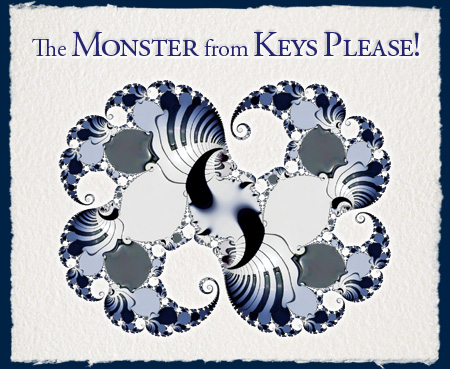
|
Three generations of piano stories with...
Carei Thomas
...and special guest Available on CD! Why get the CD when you can download the tracks for free?
$10 + $2 for US shipping |
|
|
Recorded live on St. Groundhog's Eve, 2003 |
This music is copyright 2003 by the performers. |
|
This is a recording of our second concert together, one of what has become an annual tradition. It is a joy for each of us to play with such lively, original friends, on such great pianos, on such a nice stage, and for such a wonderful audience. Our stylistic ménage has baffled critics in search of categories, but certainly seems to please our listeners. Thanks to all who have supported us in making Keys Please happen — including you, for listening to the songs on this page! Special thanks to Severin Behnen for having the kernel of this idea of an all-keyboard concert, where the free-range music can go anywhere it likes. | |
|
The Monster’s Theme
The image above is a mathematical object called a “self-squared dragon,” a type of fractal. Before the term fractal, mathematicians sometimes called these strange things monsters, and even engaged in what the philosopher Imre Lakatos called monster-barring — shunning and exclusion, a common fate for the unfamiliar! But when computers finally allowed us to see some of these monsters, they turned out to be strangely beautiful, and now we count them among our friends. What kind of dance should a friendly but misunderstood monster have? A waltz, of course!
Dance with the Wild Girl
The piece starts quietly in the forest. The Person and The Bear sit at one piano, taking a quiet walk by themselves. At measure 11, on the other piano, The Wild Girl enters, dancing with first the Bear and then with the Person. The Wild Girl’s dance disrupts and integrates elements of both dances, and gets crazier and crazier. Finally, she gets tired and Bear, Wild Girl and Person return home. I dedicate this song to my daughter, Libby, who (while being sweet) is the original Wild Girl.
Rhumbacita para Lynn
This “little Rhumba” was written for my dear wife. It should be played with delicacy, sweetness, and light.
Fragrance XVIII: Rhyssaal
Fragrances are panharmonic / pantonal / pan-durational in nature. They exude a redolent quality achieved through interesting harmonic and tonal designs but have, for the most part, a vaporous mercurial essence. They marry the avant-garde and the lyrical in ballad form. Fragrances are intuitive structures with an efflorescence of spontaneity grounded in a proven history of musical evolution.
Papayas & Hot Peppers
One of my former students loved to use ellipses…in her writing. Mary wrote in her cookbook entry: “Papayas & hot peppers…it’s a Hmong thing….” I secretly was hoping to find a fruit that Paul liked. (He did not. I put the papayas in the rests.)
Unseasonably Warm
February 1, 2003, St. Paul, MN: High 36.0°F / 2.2°C. Low 28.4°F / -2.0°C. Only three days before, the temperature had dipped to -0.4°F / -18.0°C. The sudden melt was a dramatic change — had the temperature continued to rise at that rate for another three days, it would have been summer weather.
Ballade Opus 10 No. 4
A subtle miracle, as it has been for the last 147 years. |
John’s Cage
Listeners may find it helpful to create a series of large signs as described below, and hold them up during this track at the indicated times during Todd’s piece.
Flashing Yellow, after Red
A curious, cartoonesque quip about the Portland, Oregon traffic light system…don’t expect green to follow red or yellow.
Fragrance XIV: Cjalme
Carei encourages his performers to move beyond his scores and improvise, but this fragrance was so perfectly formed just as notated, at first I wasn’t sure what I could bring to it. The answer came when I took Carei’s ever-present implicit advice and trusted my own ears: the second time, a dark, deep resonance answers the iridescent chords.
Three Autumn Poems
I set these three wonderful poems by John Minczeski for a composition class, and had them sung by another singer. The premiere was not completely satisfying to me — the singer missed much of the intention, and I did not put everything clearly in my notation. Paul said, “These deserve to be played your way. Let’s do them at Keys Please!” For several months we worked on it. Thanks, Paul!
…And the Morning Stars Sang Together
“How does newness come into the world? How is it born? Of what fusions, translations, conjoinings is it made?” (Salman Rushdie) This was the first piece of mine with which I was truly, deeply satisfied, and I rather consider it my “Opus 1.” See the written music for this piece.
Drei Kinderaffenstücken
(Ms. Nelson’s, Ms. Couchman’s, and Ms. Xiong’s classes) These songs are the products of three first grade classes from Longfellow Humanities Magnet School in St. Paul, Minnesota. They came about in a curiously inclusive way. Each student submitted three notes with durational connections and I transcribed them (in standard notation) and fixed them in G Mixolydian mode. My partner, John Minczeski (Poet), added the poems from the same classes to their music. Voila! Three monkey kid songs were born. |